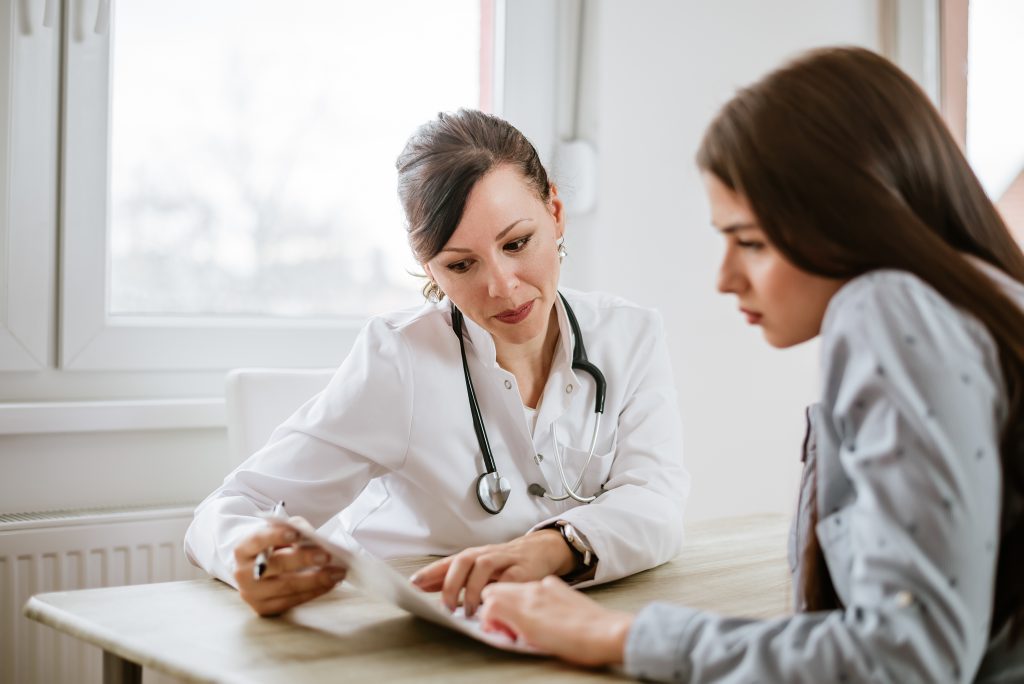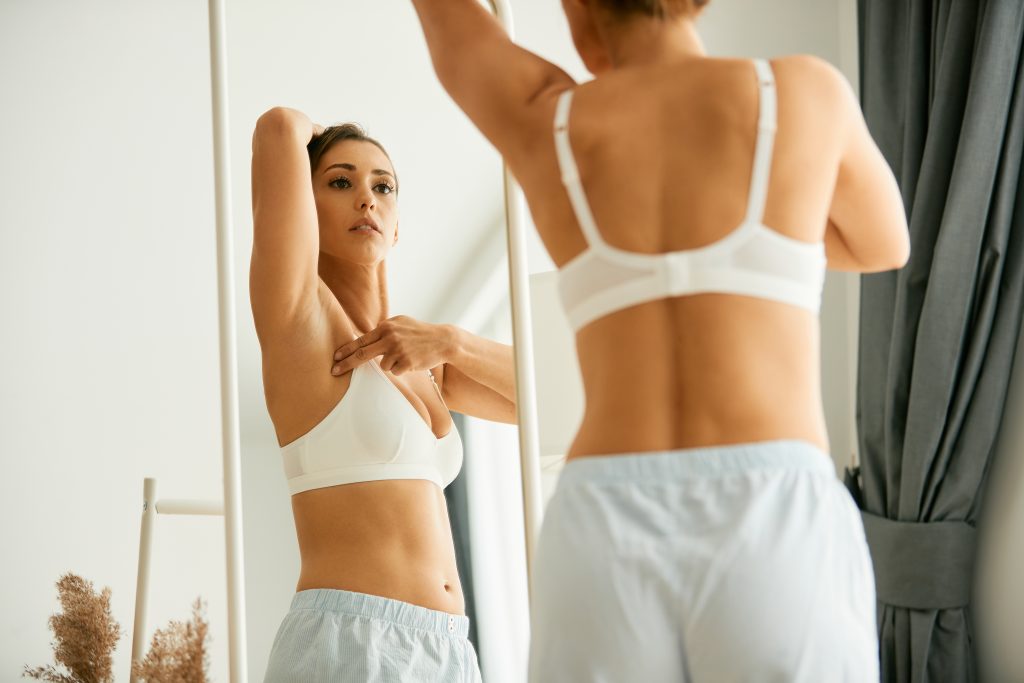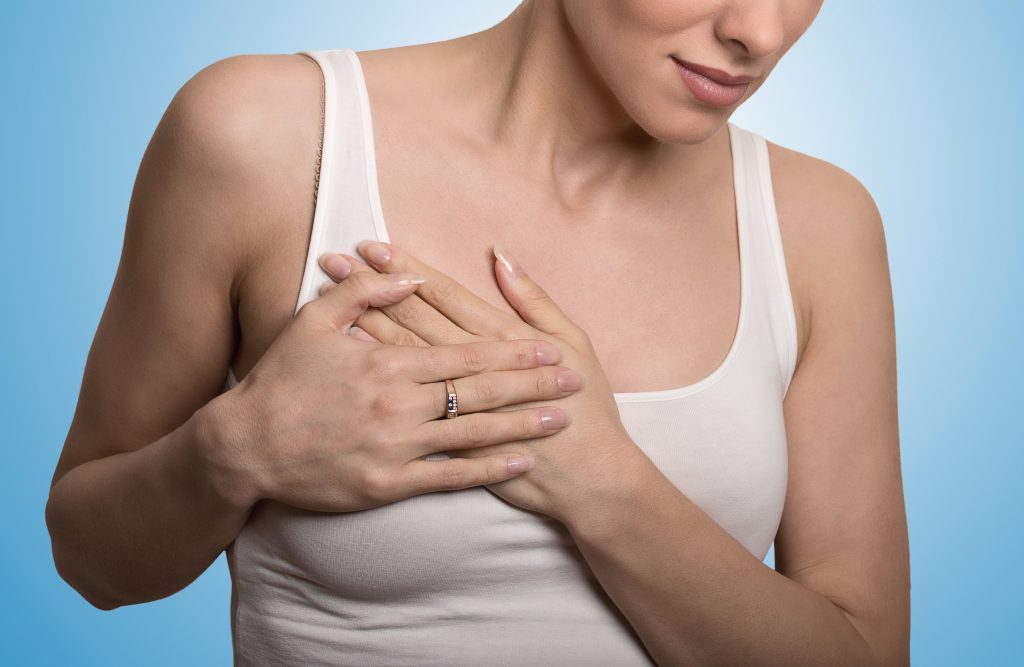October 21, 2021
How To Do a Self Breast Exam
Breast cancer can be highly treatable and has a high survival rate when caught in its early stages. Knowing how to perform a breast cancer self-exam can help you identify lumps and determine whether you need to see a medical provider for treatment.
Continue reading to learn how to give yourself a breast cancer exam and what to do next if you discover one or more lumps.
What Are Risk Factors for Breast Cancer?
Any woman can get breast cancer. However, certain factors may increase your risk.
Risk factors for breast cancer include:
- Being female

- Being 50 years of age or older
- Having a personal or family history of breast cancer
- Genetics
- Radiation exposure
- Obesity
- Using hormone therapy
- Being physically inactive
- Having dense breasts
- Having your first menstrual period before the age of 12 years
- Getting pregnant for the first time after the age of 30
- Not breastfeeding
- Never having a full-term pregnancy
- Heavy alcohol use
At-Home Breast Exam: How to Check for Breast Lumps
Jennifer Mata, PA-C, a physician with Healthcare Associates of Texas says, “We recommend to do a self breast exam one week after your menstrual cycle if you are still menstruating. If you are no longer menstruating, then be consistent by doing a self exam at the same time each month.”
Performing a breast exam on yourself is relatively easy. Here’s how to check your breast for lumps.
- Stand in front of a mirror. Keep your shoulders straight and place your arms on your hips.
- Examine your breasts for any changes in size, shape, and color. Changes include swelling, dimpling, or puckering of the skin, rash or redness.
- Raise your arms, and look for the same changes mentioned in step #2.

- Look for signs of fluid coming out of one or both nipples. This may include discharge that is bloody, yellow, watery, or milk-colored. You should not have milk-colored discharge if you are not pregnant or nursing.
- Lie down, and use your right hand to feel for any lumps or differences in your left breast. Touch your breast firmly using the first few fingers of your hand while keeping your fingers flat. “It might be helpful for you to use hand cream to easily guide your fingers across the breast tissue,” Mata advises.
- There are 2 ways to perform a self-breast exam, circular and linear. In the circular method, rub each area of your breast, using a circular motion about the size of a coin. Begin at the nipple, then move outward until you have felt all over your entire breast and into the armpit area. In the linear method, you would start with the central portion of the clavicle and glide your fingers in an up and down motion covering down the rib cage. You would continue with this motion through the armpit area of your inner arm. Use light pressure on the top layers of your skin, medium pressure on the tissue in the middle of your breast, and firm pressure to reach deeper tissue in your breast. “Either way is appropriate as long as you are covering the full area of the chest, breast and armpit. There are many lymph nodes that are found in this area and want to make sure we touch on all possible areas that might be of concern,” Mata adds.
- Repeat steps #5 and #6 using your left hand on your right breast.
- Lastly, follow all the above steps to feel your breasts while sitting down or standing in the shower using soap.
Where Are Breast Cancer Lumps Usually Found?
“Breast cancer lumps are usually found in the upper outer quadrants of each breast,” Mata says.
The best way to locate the UOQ of the breast is to visualize your breast as a clock. When checking your left breast, the UOQ is in the 9 o’clock to 12 o’clock position. When checking your right breast, the UOQ is in the 12 o’clock to 3 o’clock position.
Breast cancer lumps can be found anywhere in the breast. However, it helps to know that the majority of lumps are in the UOQ.
What Does a Breast Cancer Lump Feel Like?
“It is important to differentiate what would feel normal and what feels abnormal. This is why monthly self-breast exams are key in recognizing these abnormalities. A concerning lump may feel firm, very firm. I have personally felt cancerous lumps that have felt like gravel under the skin. The area also feels stuck to the underlying tissue so it is usually immobile. This area is usually painless which is why women may not recognize the abnormality. In a safer feeling lump you might feel it as soft and rubbery much like the end of your nose. It is mobile and can or may feel tender. This tenderness can vary at different times of the month so it is important to recognize how feeling this might be in perspective to the timing of your menstrual cycle,” Mata says.

Breast lumps are not the only sign of breast cancer. Other common signs and symptoms of breast cancer include:
- Swelling on one section of the breast, or the entire breast
- Nipple discharge (when not pregnant or nursing), including blood
- Changes in the shape or appearance of the breast
- Skin irritation on the breast or scaling
- Dimpling of the skin on the breast
- Thickened skin on the nipples or breast
- Redness on the nipples or breast
- Inverted nipple
- Swelling in the armpit
- Swelling of the arm
- Swelling around the collar bone
If you have a pea-sized lump in the breast and are also experiencing at least one of the above symptoms, make an appointment with your medical provider right away to receive a mammogram (breast cancer screening).
Finding a Breast Lump: When to Worry
Breast lumps do not always indicate breast cancer. Lumps may come and go due to hormonal changes (such as pregnancy), injuries, and benign (non-cancerous) breast conditions.
“If someone feels a lump and are still menstruating ask yourself if it as the characteristics we have described. Is it present through to the next cycle? If it is still present and with the other characteristics, see your medical provider. If no longer menstruating and the lump is present with the above characteristics, see your medical provider. If there is any doubt and you continue to have questions or concerns, never hesitate to see your medical provider for further guidance and re-assurance,” Mata emphasizes.
How Long to Wait After Finding a Lump in Your Breast
If you find a lump in your breast and you menstruate, wait until after you have your period to contact your medical provider. It’s possible that the lump will go away on its own shortly after your period ends. If you are pregnant and have a lump in your breast, mention it to your OB-GYN or midwife at your next prenatal appointment.
If you are feeling extremely stressed after finding a lump in your breast, contact your medical provider right away. Your medical provider can perform an examination and breast cancer screening if necessary and provide you with answers that may put your mind at ease.
“American College of Obstetricians and Gynecologists recommends to get a mammogram every 1-2 years beginning at age 40 for the average person. If you’re older than 40, regular mammogram screenings should be done later than 50 and to be continued to age 75,” Mata adds.
DISCLAIMER
The information featured in this site is general in nature. The site provides health information designed to complement your personal health management. It does not provide medical advice or health services and is not meant to replace professional advice or imply coverage of specific clinical services or products. The inclusion of links to other web sites does not imply any endorsement of the material on such websites.
